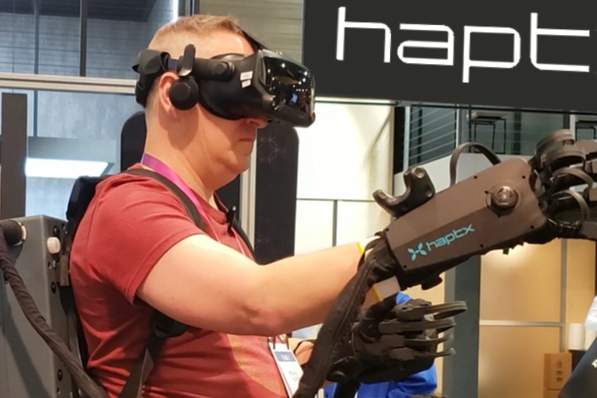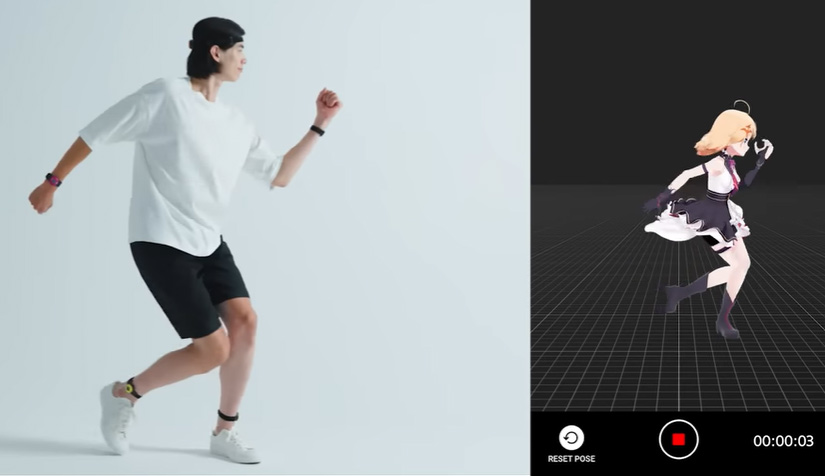
EWI at CES 2023: NFTs, MoCap and Haptics… oh my!
January 17, 2023
By Michael Klann, EWI Director of Creative Technology and award-winning immersive technologist
There’s no better playground for a technologist than CES. It’s like Candyland for tech-minded grown-ups: four days of discovering, learning and (most importantly) playing with the innovations that will shape our future.
I came to CES 2023 with a blend of curiosity and expectation. Curiosity because I hoped to finally gain some clarity about where the Metaverse and NFTs are headed; expectations because CES2023 wasn’t my first rodeo and I anticipated that I could predict most of what I’d see.
A few companies are still promoting flying cars, and the “household robots” sector is now filled with autonomous lawn mowers and snow blowers where vacuums and mops once sat. I expected new IoT gadgets and flexible display tech but got mostly remixes like ovens that live-stream dinner and refrigerators still show you what’s inside — but now by knocking twice — most of it pretty predictable.
However, there were a few gems that were worth the price of admission. To help sift through the 3,200+ exhibitors present at CES 2023, here are my top takeaways.
The term “NFT” will go away, but the technology is only getting started
Several panel discussions at CES 2023 focused on the emerging role of NFTs in the experiential marketing brand-o-sphere. Based on what I learned at CES, I predict the mystery of NFTs (what they are and how they work) is largely going to fade into the background while their adoption and use will continue to gain traction, but with labels we already understand.
When you flip on Spotify, you don’t say, “I’m gonna listen to some AAC files” (even though that’s technically what you’re doing). As users of Spotify’s technology, we don’t care if we’re listening to AACs, MP3s, WAVs or 12” records being played into a mic — we only care that we’re listening to music.
The same will soon be true of NFTs.
Think of it this way, the NFT is a unique song, the blockchain is Spotify that understands the AAC file that the song lives in, and Web3 is the player you use to listen to it. Nobody needs to understand NFTs, Blockchain or Web3 to begin using it all.
Case study time. Starbucks has been one of the first companies to get NFTs right. Aside from press releases, they aren’t calling them NFTs — the company is telling customers they can “earn and buy digital collectible stamps,” which is why adoption is taking off. Non tech-minded audiences won’t get scared away from a tech-forward trend, because they’re simply dealing with “stamps” to unlock cool coffee experiences and join online communities. And unbeknownst to them, these stamps are NFTs.
I believe 2023 will be the year that the term NFT slips into the background in lieu of words like “stickers”, “tokens”, “souvenirs” and “loyalty rewards.” Agencies like EWI will be leading the charge and encouraging their clients to embrace this trend, or these brands stand to miss the opportunity to use NFTs to deepen relationships with customers across the board.

MoCap becomes Mo’ Accessible
Anyone who’s seen the latest Avatar film has experienced the results of state-of-the-art MoCap (motion capture). Stick someone in a polkadot green unitard covered in ping-pong balls and jam an expensive camera rig in front of their makeup-dotted face and — viola! — you can get seamless, animated magic! Unfortunately, these systems are usually cost prohibitive for all but the biggest movie studios. Unless you’re James Cameron, you’re going to have a hard time getting your hands on great technology.
Until now.
At CES, our buddies at Sony showed off motion-capture for the masses with their new system — Mocopi. For less than $400, Mocopi allows the user to strap six small, puck-like sensors to their wrists, ankles, head and waist and capture movements like a Hollywood pro.
After a quick calibration, movements were transferred to an animated character in real-time on the CES floor. I was very impressed with the results from such a simple setup and can’t wait to play with this tech more. There’s no more immersive experience than something that involves your whole body and I expect to see Mocopi playing an important role an award-winning digital activation very soon.

VR Haptic Microfluidic Gloves from Haptx blew my mind
By Sunday afternoon, I was set to leave CES without having been truly amazed by anything. (Remember, I’m a seasoned industry veteran, and I went in with expectations.) The newest Magic Leap AR glasses were much improved but on par with what’s out there already. A stop by Leia Inc’s booth and a private showing from Asus demonstrated some very solid advancements in glassesless 3D Lightfield monitors and tablets. It had been a great show, but it was mostly what I had expected. Then, with only an hour left, I lined up to try haptic gloves by Haptx.
Now, I’ve used good haptic gloves before (and some that bordered on “great”) but they’re all pretty similar. Vibrations are used to tell your hand that you’re touching something, but the experience never quite feels “real.”
Until I experienced what Haptx is doing.
After putting on a Ghostbusters-esque backpack connected with hoses to a box containing a 45 PSI compressor, booth attendees slipped Haptx gloves over my hands and a Valve Index VR headset on my head. What I felt next was nothing short of amazing.
I pet a VR cat that felt convincingly soft, as hundreds of air-driven tactile actuators physically moved my skin.
I flipped an imaginary switch and I felt the metal press into and then move under my fingertips, as thousands of millimeter-sized airbags and tension motors worked in concert to let me “feel” the pressure and tension of a moving switch that wasn’t really there.
I picked up an imaginary pen. After writing my name with it, I poked the palm of my other hand with its point — all while arguing with those around me in the “real world” that the sensation I felt wasn’t really just my plastic gloves bumping against each other. They assured me my hands never touched but I still didn’t buy it until I watched the video of myself later.
Experience after experience felt surprisingly, uncannily real: water dripping into my palm, stroking an ivy plant and dropping a leaf from one hand into the other, pulling a rope taught and plucking it like a string on my Fender bass. Even a jet of steam felt soft and my brain told me it was warm. (Heat sensations will be added to future versions of Haptx’s system).
What really blew my mind was trying to move something that was stationary. The Haptx gloves only pressed and resisted my palms and fingers, yet my brain wouldn’t let my elbow and shoulder move my hand through the object — even as the demonstrator kept saying, “It’s not really there, just push your hand through it!”
At the risk of sounding overly superlative, what Haptx has created is simply incredible, and I can’t wait for the tech to become more affordable. (The enterprise version I played with currently costs around $80,000.) For now, the system targets mission-critical use cases, and (as with most ground-breaking tech) it will take time for it to trickle down. But it’s sure to find its way to us eventually, especially for Metaverse applications. Speaking of which…
The Metaverse
I was hoping to get some clarity around where the Metaverse is actually heading, and the word “metaverse” was everywhere at CES, but what lived under that masthead was all over the place. Lots of new players have entered the VR headsets and AR glasses space, a lot of low-res open worlds that felt like a rehash of the SIMS, digital twins (both human and machine) are being used to operate heavy equipment remotely or monitor medical conditions.
All of these technologies promise a future where being “present” may not have anything to do with physically being “nearby.”
In a strange way, the range of disparate technologies at CES 2023 perfectly sum up what the Metaverse is and where it’s headed. Standalone tools like virtual points, stamps, and tokens, digital storefronts and events, haptic suits, and digital twins aren’t the metaverse — and yet, at the same time, they are the very building blocks that will make up the Metaverse. The Metaverse isn’t going to be something defined for us… it will be defined by us. Agencies and brands are best advised to keep moving forward, into the future.
